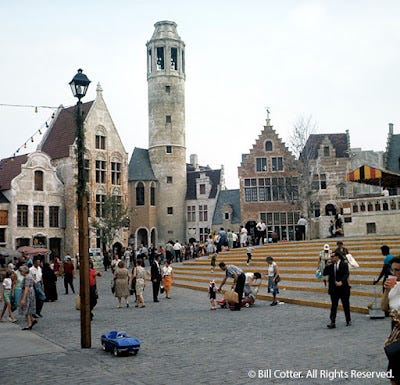#WorldsFair64: The Taste of Belgian Waffles

This delicacy from an unfamiliar part of the world dazzled World’s Fair audiences.
by Rich Watson
Belgian waffles didn’t debut at the 1964 World’s Fair, but it was where they were popularized.
A wider variety of exhibiting nations came to the Fair than in previous years. As a result, dishes we take for granted today—falafel, tandoori chicken, hummus, and kimchi, among others—first made a splash with an American audience there.
The biggest hit may have been this dessert from Brussels.
Belgian food
Modern Belgium begins with the country’s independence from the Netherlands in 1830.
Belgian food borrows from French, Dutch and German sources. Beer and Brussels sprouts, of course, are well known. Chocolates, particularly pralines, are popular, as well as Belgian fries. Here’s a basic guide to traditional Belgian food.
The waffle and the waffle iron
The concept of the waffle dates as far back as ancient Greece. During the Middle Ages, they were made with honey and cinnamon, pressed between two iron plates that depicted Bible scenes, landscapes and coats of arms. In the eighteenth century, waffles used more butter and sugar.
In 1869 American Cornelius Swartwout patented his invention, the modern waffle iron.
Brussels waffle vs. Liege waffle
What many people know of as the Belgian waffle is actually the Brussels waffle. They’re made with yeast batter, not pancake batter, which provides a crispy outside texture and a fluffy inside one. They’re served with strawberries and cream, no syrup. Traditionally, they’re eaten by hand, without a fork.
The other kind of waffle is the Liege, a bit harder to make and more expensive. It uses pearl sugar in the dough. The crust caramelizes and the inside is denser. It’s rounder than Brussels waffles. Belgians consider it the better of the two.
Belgian Walter Cleyman served waffles at Expo 58, the World’s Fair in Brussels in 1958. Four years later, he brought them to Seattle’s Century 21 Exposition.
Then came New York, two years after that.
Maurice Vermersch at the World’s Fair’s Belgian Village

For the 1964 Fair, Belgium created a facsimile of a Flemish walled village from 1800. At four acres, it was the largest international exhibit. It wasn’t completed until the near end of the 1964 session. By the 1965 session it was fully operational. Admission was $1.25; sixty cents for kids. Among its attractions included:
over a hundred houses,
a fifteenth-century church,
crooked, cobbled streets,
a canal,
a carousel,
Gilles dancers and other folk dancers,
villagers in period costume, and
a beer hall.
Here’s a menu from a Hungarian restaurant in the Belgian Village.
It also had a waffle stand. Maurice Vermersch was Belgium’s waffle maker this time. He ran it with his family, twenty-four machines to make the waffles, and a team of ten people to slice the strawberries. He used yeast as the leavener and greased the iron with lard. The waffles sold for a dollar each.
The demand was great, according to Vermersch’s daughter MariePaule Vermersch in this 2014 interview:
The public was amazed…. They would say, ‘How come it’s so light?’ They were so used to the heavy American waffles.
At the time, Belgium was unfamiliar to most Americans. Maurice Vermersch sold them under their original name, Brussels waffles, at first. Later, he marketed them as “Bel-Gem Waffles,” a play on the name Belgium.
Vermersch’s wife would refuse to serve waffles with forks and knives. Native Belgians ate them by hand, on the go, so that would be how Americans ate them.
Waffles today
In America, waffles are commonly served as a breakfast food, in a variety of styles. When served with chicken, it’s a popular Amish or Southern dish. Around the world, they look pretty different.
When people think of the 1964 World’s Fair, though, waffles are among the most popular memories. This 2014 podcast interview with MariePaule Vermersch goes into further detail about waffles and her experience at the Fair.
————————
Did you eat waffles at the World’s Fair?

